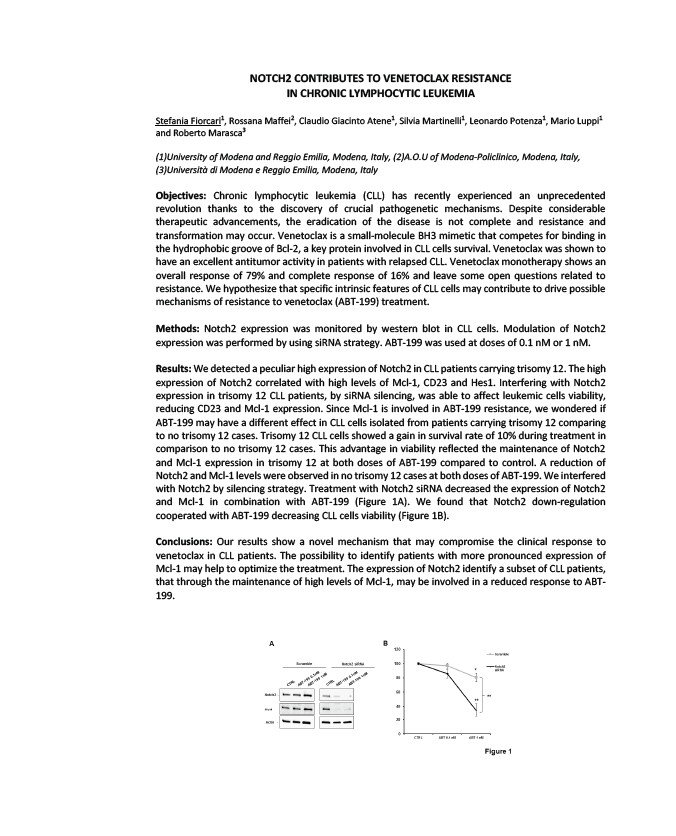
NOTCH2 CONTRIBUTES TO VENETOCLAX RESISTANCE
IN CHRONIC LYMPHOCYTIC LEUKEMIA
Stefania Fiorcari1, Rossana Maffei2, Claudio Giacinto Atene1, Silvia Martinelli1, Leonardo Potenza1, Mario Luppi1
and Roberto Marasca3
(1)University of Modena and Reggio Emilia, Modena, Italy, (2)A.O.U of Modena-Policlinico, Modena, Italy,
(3)Università di Modena e Reggio Emilia, Modena, Italy
Objectives: Chronic lymphocytic leukemia (CLL) has recently experienced an unprecedented
revolution thanks to the discovery of crucial pathogenetic mechanisms. Despite considerable
therapeutic advancements, the eradication of the disease is not complete and resistance and
transformation may occur. Venetoclax is a small-molecule BH3 mimetic that competes for binding in
the hydrophobic groove of Bcl-2, a key protein involved in CLL cells survival. Venetoclax was shown to
have an excellent antitumor activity in patients with relapsed CLL. Venetoclax monotherapy shows an
overall response of 79% and complete response of 16% and leave some open questions related to
resistance. We hypothesize that specific intrinsic features of CLL cells may contribute to drive possible
mechanisms of resistance to venetoclax (ABT-199) treatment.
Methods: Notch2 expression was monitored by western blot in CLL cells. Modulation of Notch2
expression was performed by using siRNA strategy. ABT-199 was used at doses of 0.1 nM or 1 nM.
Results: We detected a peculiar high expression of Notch2 in CLL patients carrying trisomy 12. The high
expression of Notch2 correlated with high levels of Mcl-1, CD23 and Hes1. Interfering with Notch2
expression in trisomy 12 CLL patients, by siRNA silencing, was able to affect leukemic cells viability,
reducing CD23 and Mcl-1 expression. Since Mcl-1 is involved in ABT-199 resistance, we wondered if
ABT-199 may have a different effect in CLL cells isolated from patients carrying trisomy 12 comparing
to no trisomy 12 cases. Trisomy 12 CLL cells showed a gain in survival rate of 10% during treatment in
comparison to no trisomy 12 cases. This advantage in viability reflected the maintenance of Notch2
and Mcl-1 expression in trisomy 12 at both doses of ABT-199 compared to control. A reduction of
Notch2 and Mcl-1 levels were observed in no trisomy 12 cases at both doses of ABT-199. We interfered
with Notch2 by silencing strategy. Treatment with Notch2 siRNA decreased the expression of Notch2
and Mcl-1 in combination with ABT-199 (Figure 1A). We found that Notch2 down-regulation
cooperated with ABT-199 decreasing CLL cells viability (Figure 1B).
Conclusions: Our results show a novel mechanism that may compromise the clinical response to
venetoclax in CLL patients. The possibility to identify patients with more pronounced expression of
Mcl-1 may help to optimize the treatment. The expression of Notch2 identify a subset of CLL patients,
that through the maintenance of high levels of Mcl-1, may be involved in a reduced response to ABT-
199.